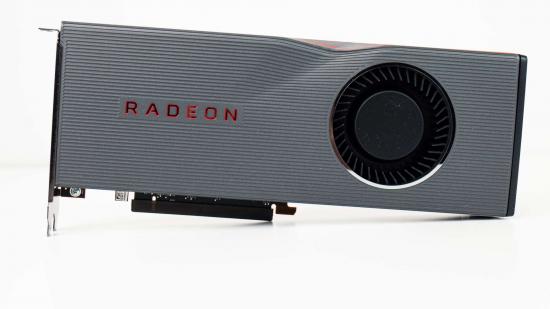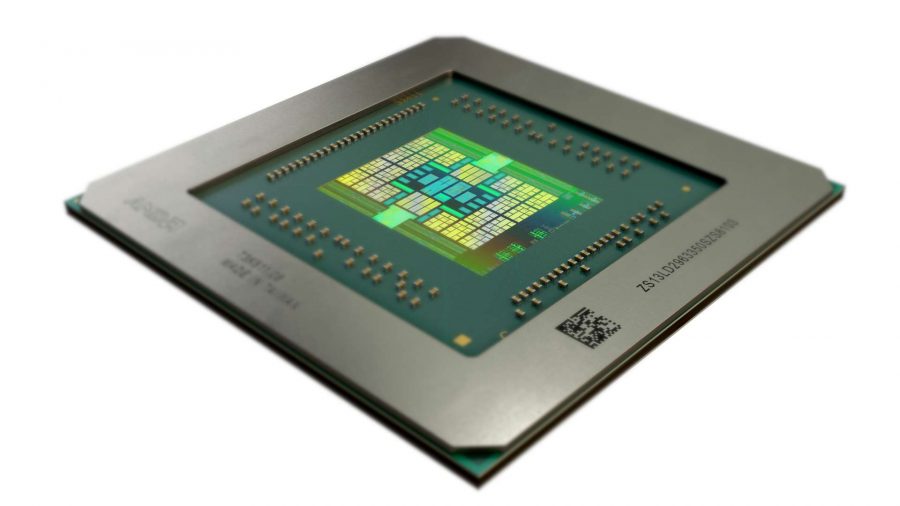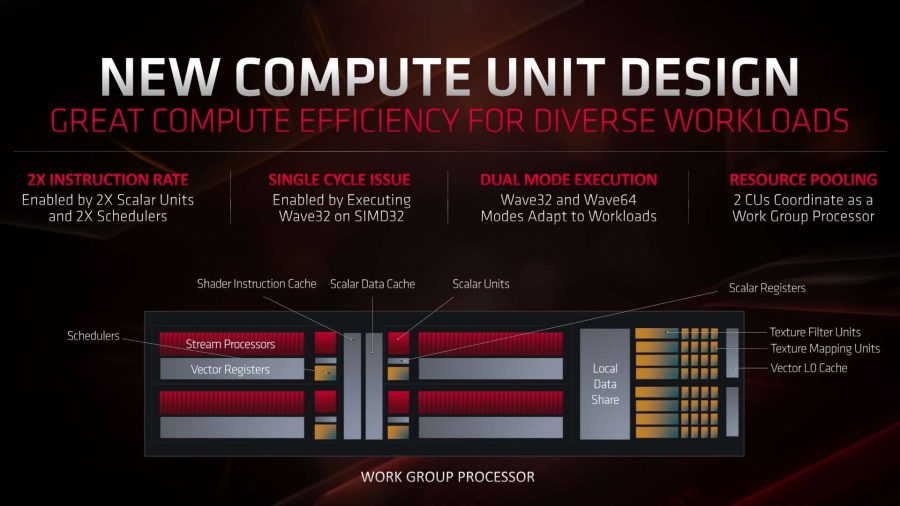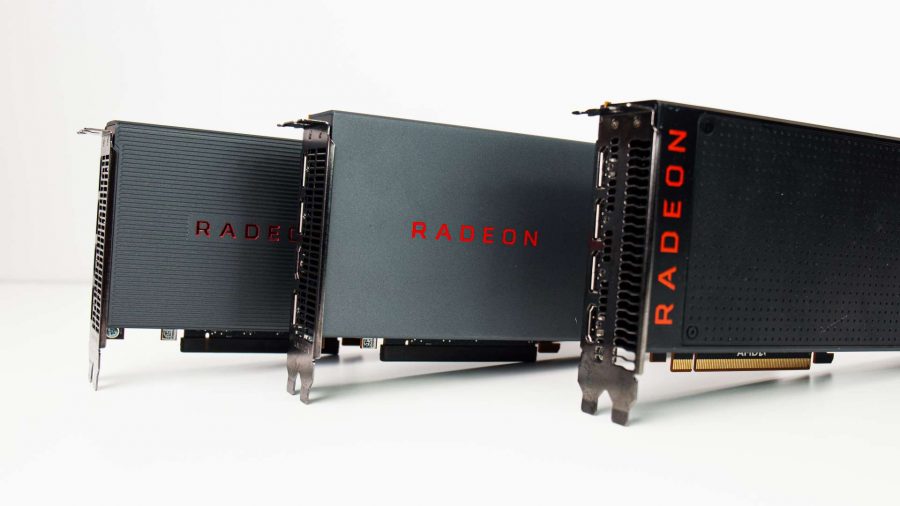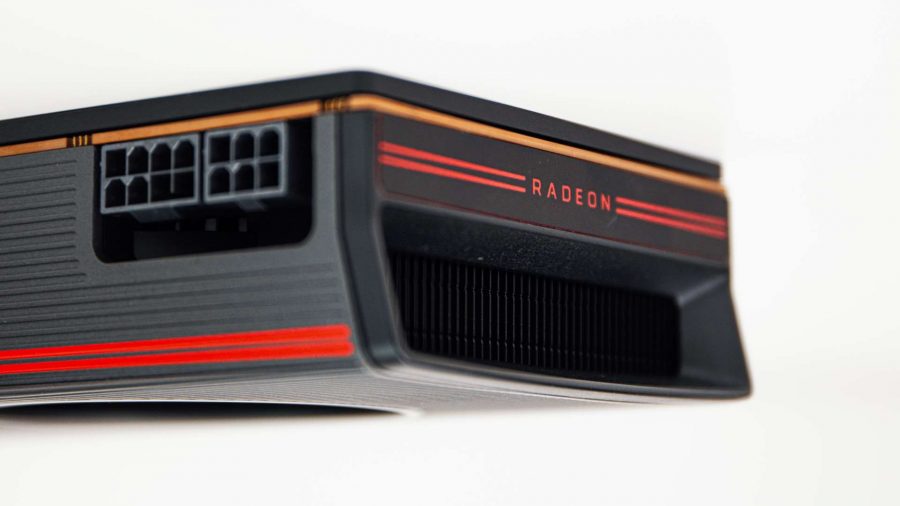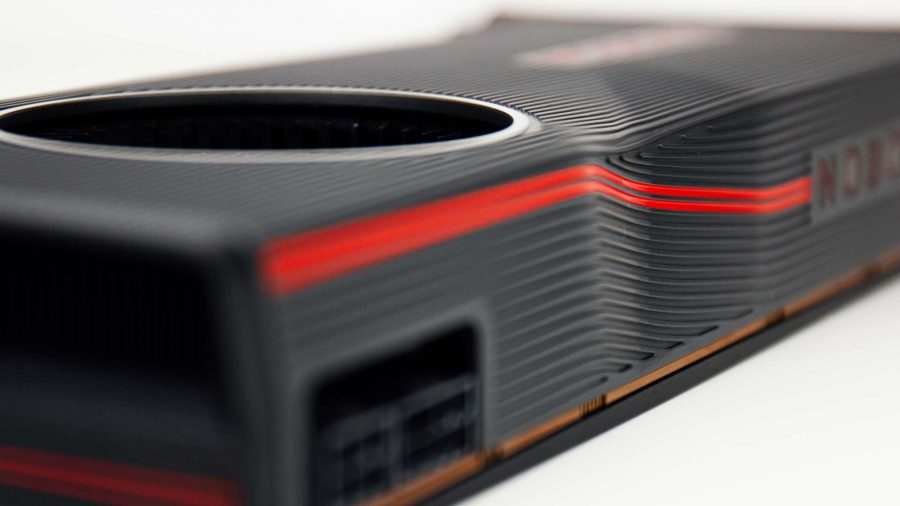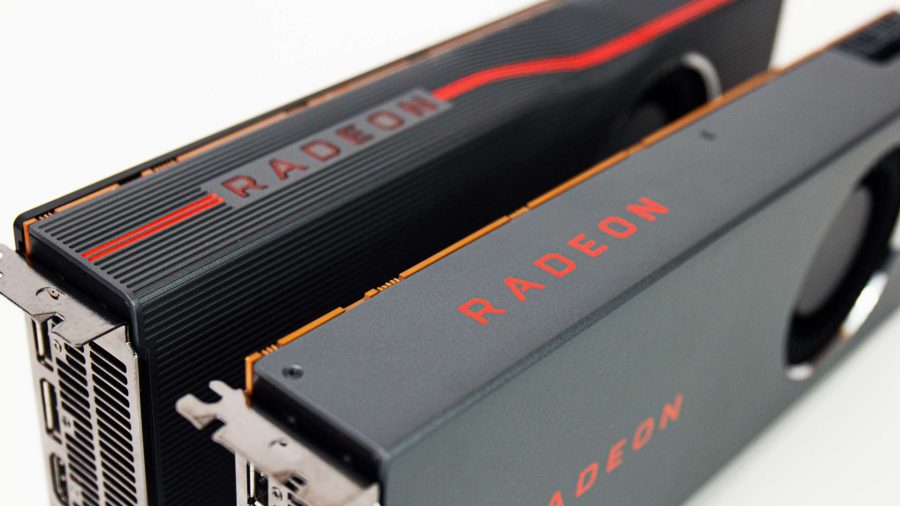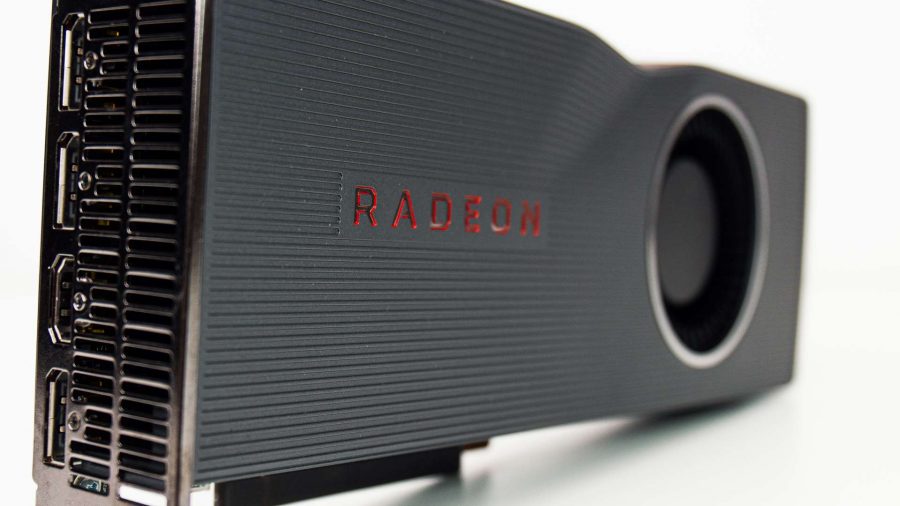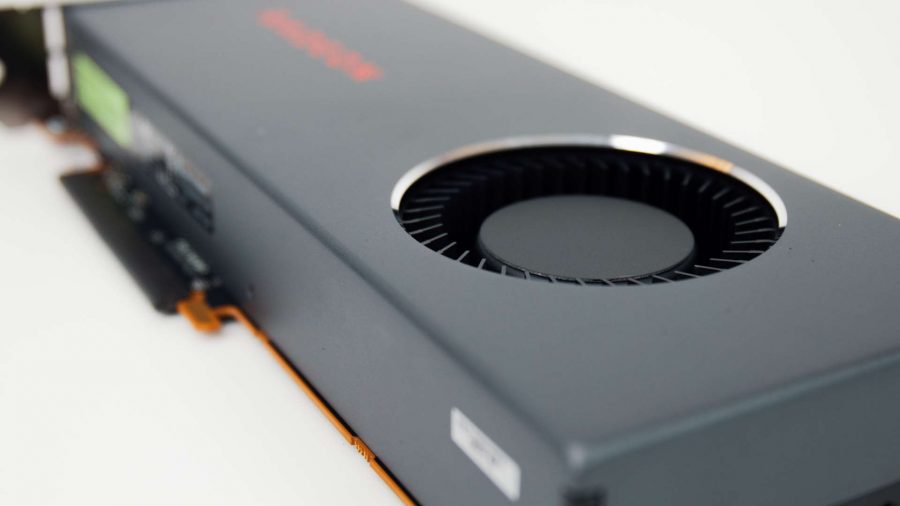Our Verdict
An impressive gen-on-gen performance bump from Vega, and with a smart new gaming architecture. And now, by virtue of being priced directly against the mostly slower Nvidia RTX 2060 Super instead of the 2070 Super, AMD has got a GPU on its hands that deserves its praise. It's just a little toasty is all...
The AMD RX 5700 XT is the first Radeon graphics card to ship with the Navi GPU architecture… a codename that was been whispered in hushed tones for many years now. But the red team is finally shouting it loud and proud, and the RX 5700 XT is the first GPU on the planet to use the brand new, gaming-focused RDNA-based design. And it just happens to also be one of the best-looking AMD graphics cards I’ve ever tested.
But beauty is only skin-deep; what can the new AMD Navi RDNA GPU inside the curvy/dented shroud actually deliver in terms of gaming performance? And how does it stand up against the newly minted Nvidia RTX 2070 Super and RTX 2060 Super cards now that AMD has cut its initial retail price just days before launch?
When AMD first announced the new GPUs back at E3 its sights were very much trained on the original Turing-based RTX 2070 and RTX 2060 cards from Nvidia, but now the goal posts shifted with the latest GeForce release pushing the performance targets up, but without changing the amount of money you’re being expected to pay for it. And AMD has had to respond accordingly.
While not the first 7nm graphics cards to hit our gaming PCs – the short-lived Radeon VII has that dubious distinction – the Radeon RX 5700 XT combines TSMC’s 7nm production process with a brand new graphics architecture. The Navi RDNA GPUs represent the first time, in a long time, that AMD has focused a design purely on gaming, leaving the GCN architecture to keep rocking on the compute tip for the professional level server chips of the future.
Though there is a slight concern about Navi GPU’s use of the 7nm lithography, and the fact that both this RX 5700 XT and the cut-down RX 5700 launched at the same time as the new 7nm Ryzen 3000 processors. Can AMD and TSMC manufacture enough of both to keep the ravening hordes of PC peops fed with 7nm silicon? It turns out that’s been a struggle, and if reports are to be believed could continue to be so in the future too.
At least AMD now has its own retail channel, via the store at amd.com, to be able to ensure there are reference-priced cards available whenever there’s stock. AMD hasn’t historically been able to provide any sort of control over what happens to pricing when availability becomes tight in times past, leaving prices to spiral out of control as stock dwindles at online retailers. AMD still can’t directly exercise any control over them to stop that happening, but with its own store selling at MSRP the red team can now provide an alternative channel.
AMD Radeon RX 5700 XT specs
We’ve covered off the details of the new GPU design in our AMD Navi RDNA architecture deep-dive piece, but the biggest change the red team has made between Navi and Vega silicon is in the make up of the new Compute Unit. The RDNA CU is designed around ‘workgroup processors,’ or essentially a pair of compute units strapped together, sharing some resources to function better on larger workloads together.
But despite sharing certain resources, the RDNA compute units in Navi actually have more dedicated silicon inside them compared with a traditional GCN compute unit. Each CU now has one extra scheduler and one extra scalar unit, doubling up their counts on both scores. And that’s specifically to offer double the potential instruction rate in order to create a more efficient compute unit dedicated to standard gaming graphics workloads.
This tailoring for gaming is most obvious in arguably the biggest architectural change of the RDNA architecture: boosted instructions per clock. Basically AMD has focused on improving the straight line gaming performance of its GPUs where before, with Vega, it was looking more towards the parallelism necessary for improved compute workloads.
That’s why these Navi RDNA chips are dedicated gaming chips.
In terms of the actual specifications for the RX 5700 XT card and its version of the 7nm Navi 10 GPU, it’s sporting the full 40 CU implementation of the chip and that means you’re getting 2,560 RDNA cores at its heart. Allied to that 251mm2 GPU is 8GB of GDDR6 memory running at 14Gbps across a 256-bit memory bus.

| Radeon RX 5700 XT 50th Anniversary Ed. | Radeon RX 5700 XT | Radeon RX 5700 | |
| GPU | AMD Navi 10 | AMD Navi 10 | AMD Navi 10 |
| Lithography | 7nm FinFET | 7nm FinFET | 7nm FinFET |
| Compute units | 40 | 40 | 36 |
| RDNA Cores | 2,560 | 2,560 | 2,304 |
| Memory | 8GB GDDR6 | 8GB GDDR6 | 8GB GDDR6 |
| Memory bandwidth | 448GB/s | 448GB/s | 448GB/s |
| Boost clock | 1,980MHz | 1,905MHz | 1,725MHz |
| Game clock | 1,830MHz | 1,755MHz | 1,625MHz |
| Base clock | 1,680MHz | 1,605MHz | 1,465MHz |
| Transistors | 10.3bn | 10.3bn | 10.3bn |
| Die size | 251mm2 | 251mm2 | 251mm2 |
| TDP | 225W | 225W | 180W |
| Price | $449 | £429 | $399 | £380 | $349 | £340 |
In short, that’s the same essential memory configuration that Nvidia has now brought to bear on all of its non-Ti RTX 20-series graphics cards. And it wouldn’t be much of a surprise if that change with the Super edition GeForce cards is based on the fact that AMD has been resolutely offering superior memory specs with its GPUs for generations.
The reporting of the RX 5700 XT’s graphics silicon clock speed frequency has changed a little in this new generation of AMD cards, however. In a similar way to how the Radeon VII was marketed with a peak engine clock beyond what you’d see in general gaming use, the RX 5700-series cards have a boost clock which ostensibly fulfils the same role. The game clock then is the figure you’re likely to see more often when you’re running game workloads through your graphics processor.
But, that said, during testing our RX 5700 XT card comfortably topped its rated game clock by a fair margin. While the Navi 10 GPU inside has a rated game clock of 1,755MHz we saw the frequency moving between a low of 1,785MHz and 1,943MHz during an extended period of back-to-back Metro Exodus runs. As a minimum that’s higher than the game clock and goes beyond the 1,905MHz rated boost clock on the RX 5700 XT specs sheet.
AMD Radeon RX 5700XT benchmarks
PCGamesN test rig: Intel Core i7 8700K, MSI Z390 Gaming Edge AC, 16GB Corsair Dominator DDR4 @3,200MHz, 1TB Seagate Firecuda, Corsair H100i RGB, Philips BDM3275
AMD Radeon RX 5700 XT performance
If you take the RX 5700 XT gaming performance in isolation, looking at the performance difference between the last-gen Vega cards and the new Navi GPU, the amount of progress that AMD has made in the intervening time becomes clear.
Unfortunately we don’t have our old Radeon VII to run full comparative testing on right now – a mix-up between The Sun newspaper, Razer, and AMD has meant some UK courier has wandered off with a $699 graphics card for free – but we do have a couple of referential benchmarks that make for interesting reading. And from those you can glean there is essentially next to no difference between the performance of the RX 5700 XT and the Radeon VII… and the new card is now $300 less.
So, the expensive inaugural 7nm card which launched in February has been instantly rendered obsolete by the top Navi GPU. Anyone who spent $699 on that card should rightly feel a little sick today.
The Radeon Vega 64, a $499 card when it first launched (though one which subsequently went up to over $1,000 at times due to limited stock and crazy miners), is notably off the pace too. In general terms the RX 5700 XT is around 20% quicker than the Vega 64 while consuming a touch less power too.
The comparison with the big Vega GPUs is fascinating, and shows how much smarter the gaming-focused RDNA design of the Navi graphics silicon is. With a third fewer compute units and unified shaders than the 7nm Vega the similarly 7nm Navi 10 can deliver the same levels of gaming performance. Against the 14nm Vega the difference is even more stark – the RX 5700 XT has 38% fewer compute units and shaders than the Vega 64 and yet delivers 20% higher frames per second.
Were we purely looking at a generation-to-generation comparison for the new AMD cards the top-spec Navi easily looks like a genuinely quality graphics card for the masses.
But we’re not just looking at the Radeon GPUs in isolation. With the release of the RTX 2070 Super and RTX 2060 Super cards, and the effective retiring of the original RTX 2070, Nvidia is forcing us to make the necessary comparisons between these new GPUs and the results weren’t nearly as favourable for AMD as they would have been just a couple of weeks ago.
Against the OG RTX 2070 we were expecting the RX 5700 XT to win some and lose some in terms of benchmarks, but against the new RTX 2070 Super variant it’s a defined loss across the board.
Before the Super cards’ released AMD also dropped a note into its reviewer’s guide to remind us the original RTX 2070 Founders Edition we might be testing against was actually sold at the higher price of $599. In that situation, with the 2070 and 5700 XT trading gaming blows, and being sold at $449, the cheaper Radeon card would have looked a real bargain. But not only has that old 2070 now been retired, so has the Founders Edition schtick too. So the $499 RTX 2070 Super is the base price, and that extra $50 over the 5700 XT’s original price was matched by the extra performance of the GeForce GPU.
The shifting sands of the GPU market, however, encouraged AMD to slash the pricing of its new RX 5700-series cards pre-launch in order to switch their respective targets. Now the RX 5700 XT is priced head-to-head with the RTX 2060 Super, and in this newly focused fight lower down the GPU stack the Radeon card does come out top.
There are a few occasions where the RTX 2060 Super manages to achieve some level of gaming parity with the XT, but on the whole the Navi-based card absolutely has the edge.
It’s also not hugely off the pace compared with the RTX 2070 Super card – often the performance delta is less than 10% – and when it’s priced $100 cheaper you can see the red team has really gone for the GeForce jugular on pricing.
But the Navi 10 GPU has nowhere to go from here, it’s effectively running at the ragged edge, as is often the way with AMD’s graphics cards, and has been pushed as far as it can go to be able to offer this level of performance. The Nvidia card, with it’s much lower temps and more efficient GPU, has more overclocking performance in the tank.
You are, of course, also getting access to the current and future real-time ray tracing effects being added to more and more games with the GeForce GPUs. Were the pricing still mostly equivalent I’d have comfortably recommended the RTX 2070 Super as the absolute go-to GPU for gamers looking for high-end performance and its support for next-gen visual effects, but in straight frame rate terms the $100 cheaper RX 5700 XT now makes it a tougher pick.
If you had the money you’d still want the RTX 2070 Super, but AMD is now offering close to the basic rasterised performance for a lot less cash.
We do, however, need to talk about more than just straight frame rate performance too; we need to talk about power and thermals. That sexy, curvy new shroud looks fantastic – honestly, even better in the flesh – but despite the fact we’re now talking about a 7nm GPU that’s meant to be far more efficient than its 14nm forebears, we’re still looking at the same exact thermal performance as the RX Vega 64.
That is to say: hot. And loud. We can’t forget or forgive the fact that when it’s running the GPU hard the cooling fans spin up to classic AMD turbine levels.
The 12nm Nvidia RTX 2060 Super, by contrast, runs almost 20°C cooler, operates far quieter, and still delivers similar gaming performance while using far less power. And all that from a GPU which is 77% bigger too.
That should tell you all you need to know about the relative efficiency of the Nvidia Turing graphics architecture vs the AMD Navi design. Try as it might AMD simply cannot deploy a GPU as powerful, as cool, or as efficient as Nvidia’s engineers can. Just think about how much more efficient Turing could be at 7nm…
AMD Radeon RX 5700 verdict
This is exactly why increased competition in the market is going to be great for gamers. AMD announces the RX 5700 XT at $450, promises it will beat an RTX 2070, and then Nvidia responds by changing its pricing model and introducing a faster version of its old card for the same price. Then AMD hits back and slashes the price of its Navi-based GPUs just days before the launch and shakes up the graphics card market once more. It’s been a wild couple of weeks.
Before the XT price drop it really wasn’t looking so good for AMD. The card’s hot, power hungry, and slower than the previously similarly priced RTX 2070 Super. The extra $50 Nvidia was then asking seemed about right for what you were getting in return with its higher performance and the more next-gen feature set.
But where it’s price is now $100 less than the new Nvidia card, and often only 10% behind in standard, rasterised gaming pace, the RX 5700 XT is a far more tantalising option. And looking at the gen-on-gen performance difference against the $499 RX Vega 64, and the $699 Radeon VII, the progress AMD has made with the Navi RDNA architecture is obvious.
Though spare a thought for the poor bastards who went out and bought a Radeon VII in February. They’ve got to be livid about now. The 7nm early adopters have really been cut adrift.
Power and thermals are still an issue though, especially considering this is a 7nm part. But when the third-party cards are released, with improved cooling options, it’s going to almost be a no-brainer if it can maintain this ultra competitive pricing.
Unless you’re 100% on board the ray-tracing hype train that is, and, given the noises coming from game devs at E3 last month, a lot of the gaming industry is… including Sony and Microsoft. And if the consoles are demanding ray traced visual effects for the next generation then it’s going to become almost standard for next-gen titles. Nvidia has already laid a lot of the ground work for PC gamers.
It is worth mentioning the overclocking performance of the Navi card, however. You can push the RX 5700 XT up to stock RTX 2070 Super performance, but then you can easily overclock the Nvidia card to go even further thanks to its far superior cooling and efficiency.
Then there’s the RX 5700. Out of the box the cut-down Navi GPU has its frequency and power artificially limited to prevent users from accessing its full potential. But there is a simple way to unlock the RX 5700 via software and overclock it to at least XT levels, and sometimes more. That makes the non-XT a rather tempting option right now.
But the RX 5700 XT still looks like a great straight rasterised rendering card. It may have taken some price massaging to really make the RX 5700 XT the competitive part it deserves to be, but where it stands now – knocking out the RTX 2060 Super and genuinely pushing the much more expensive, but still faster, RTX 2070 Super – AMD has made a hell of a return to the graphics card game with its brand new Navi architecture.
